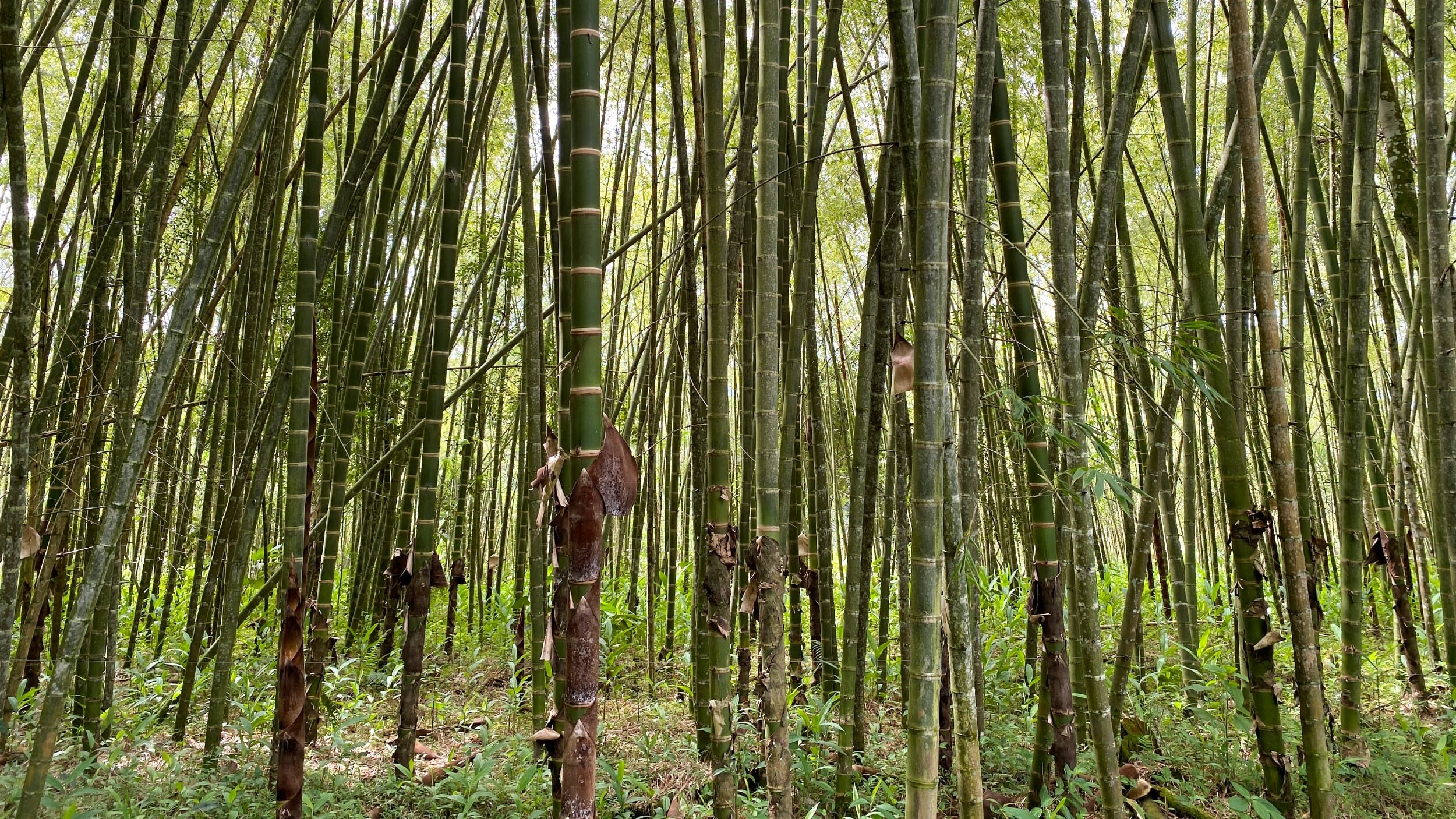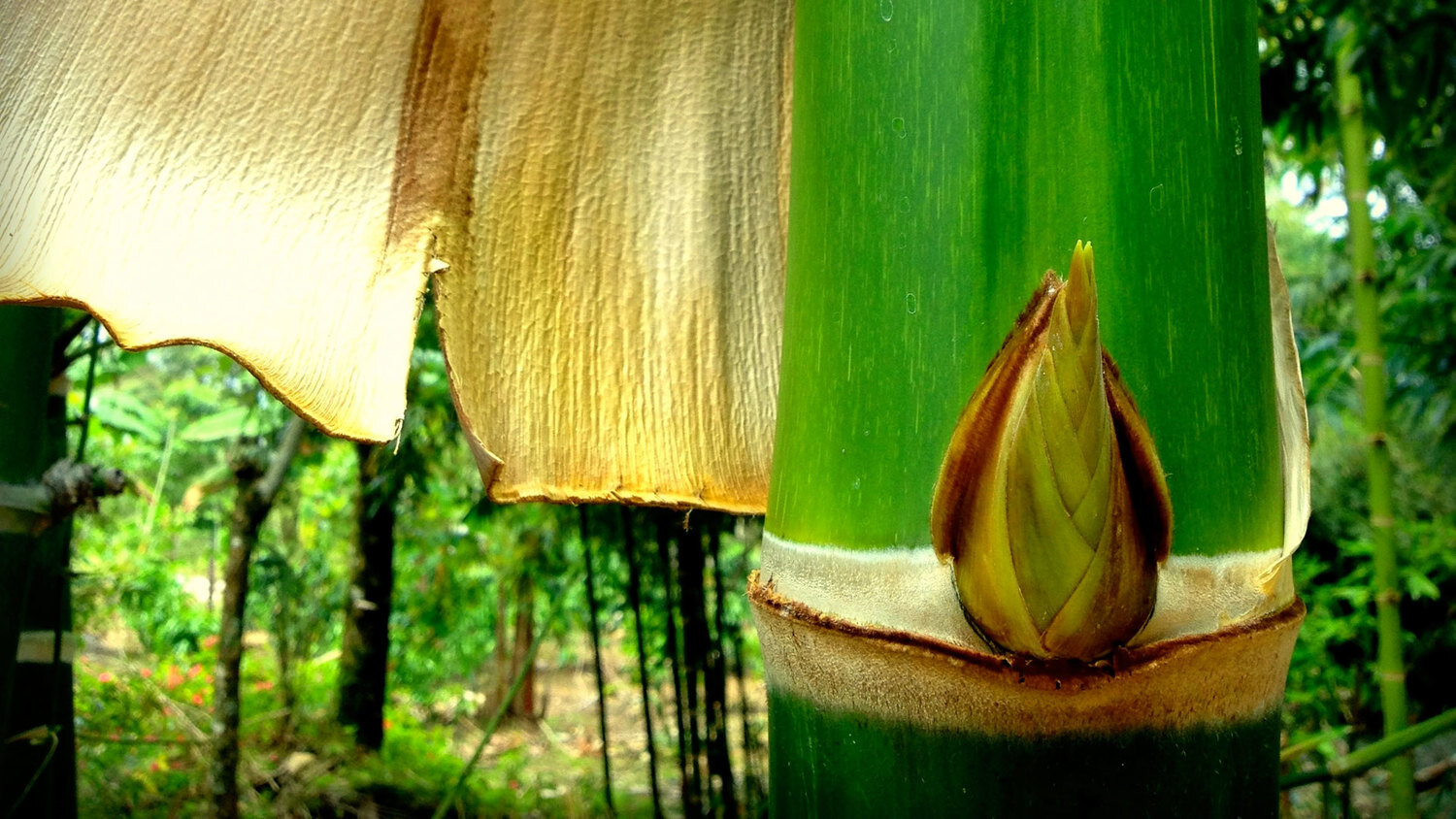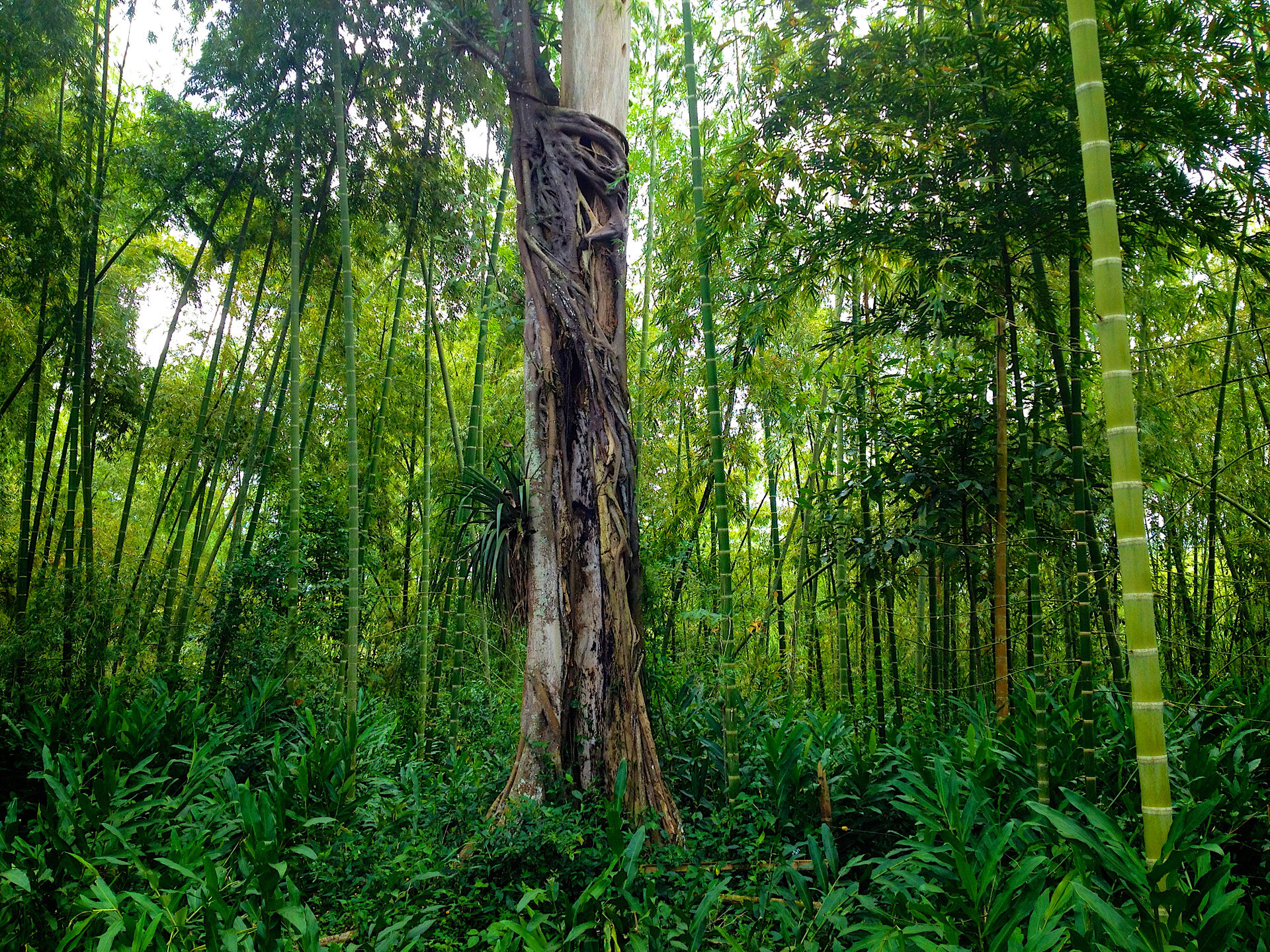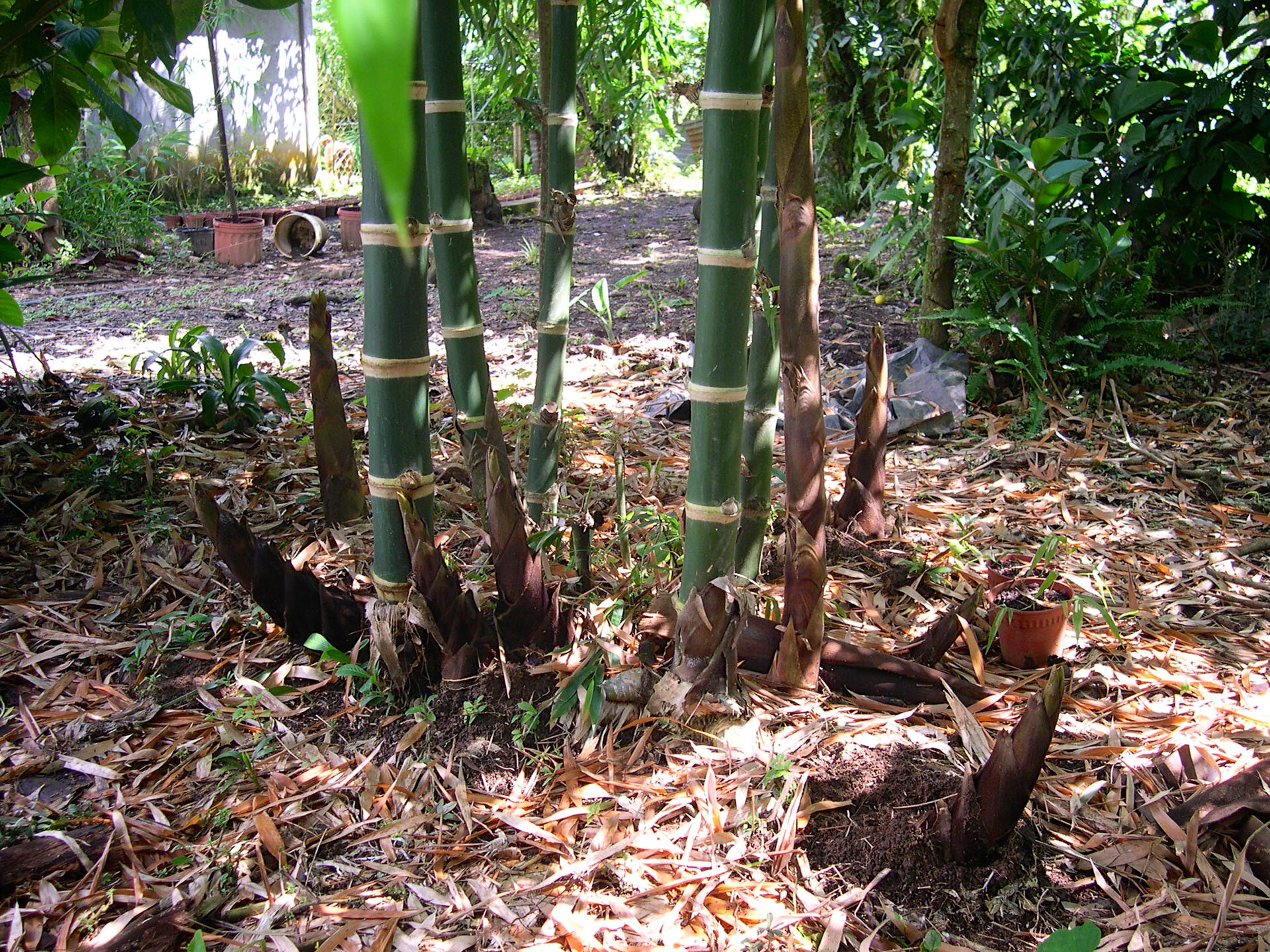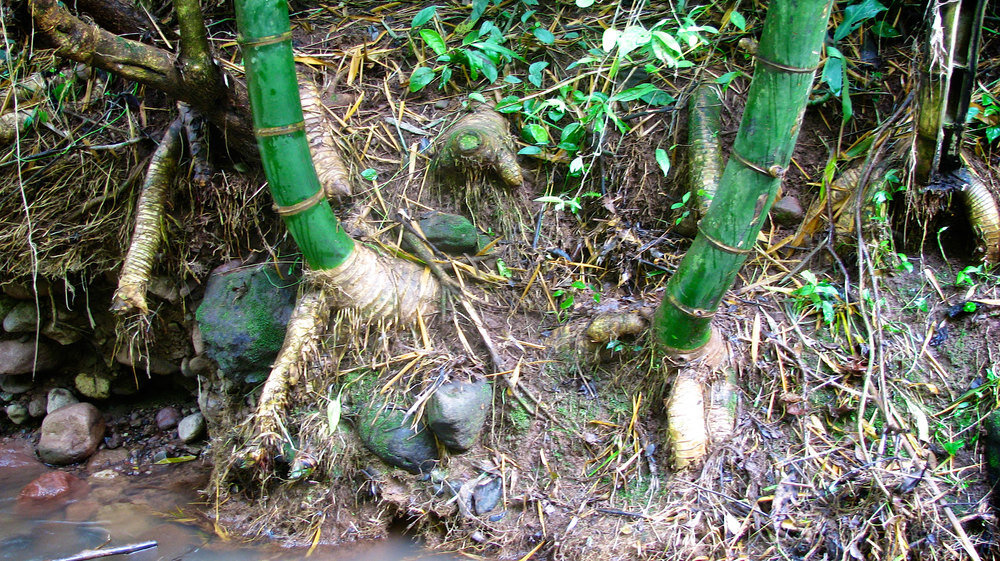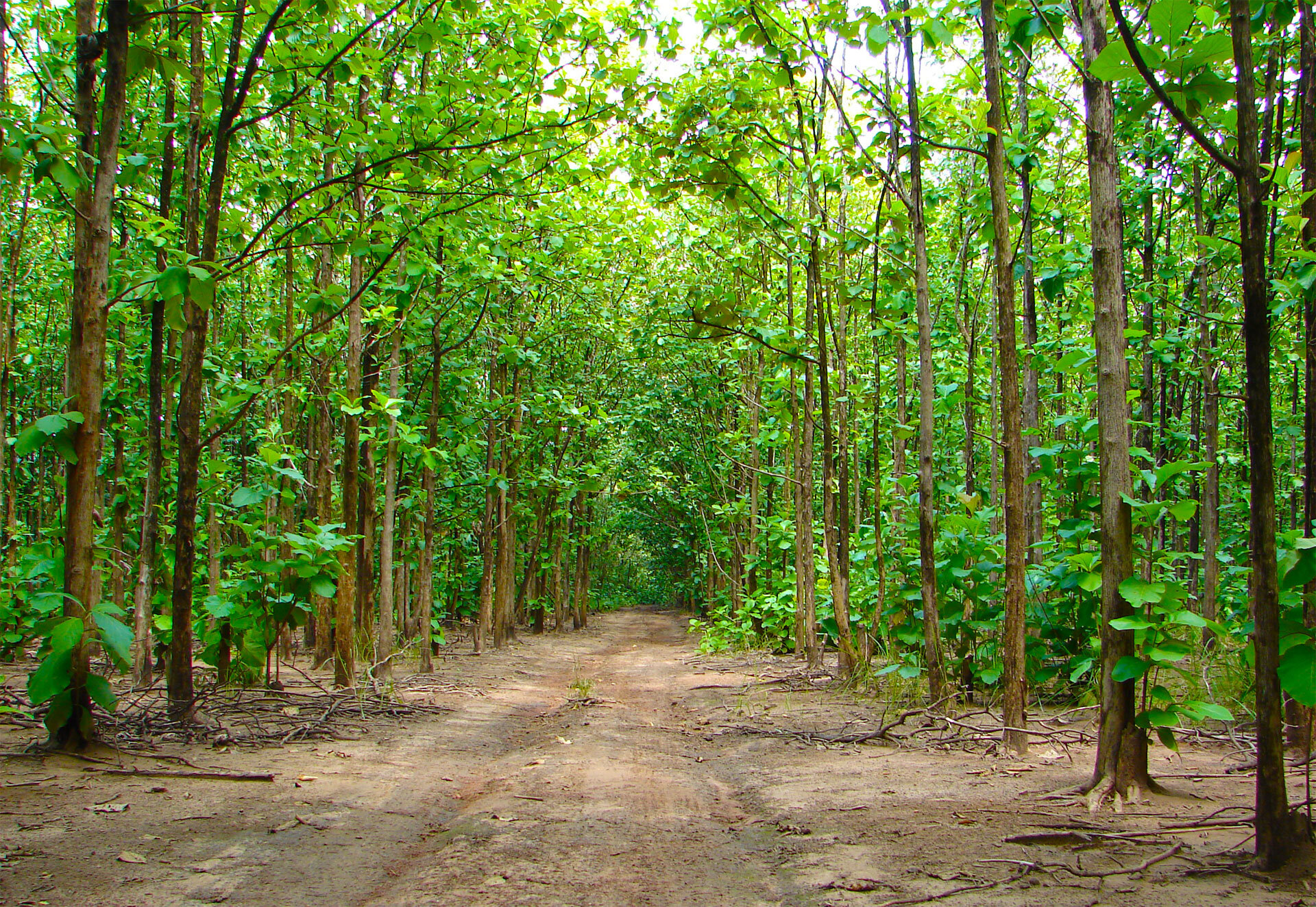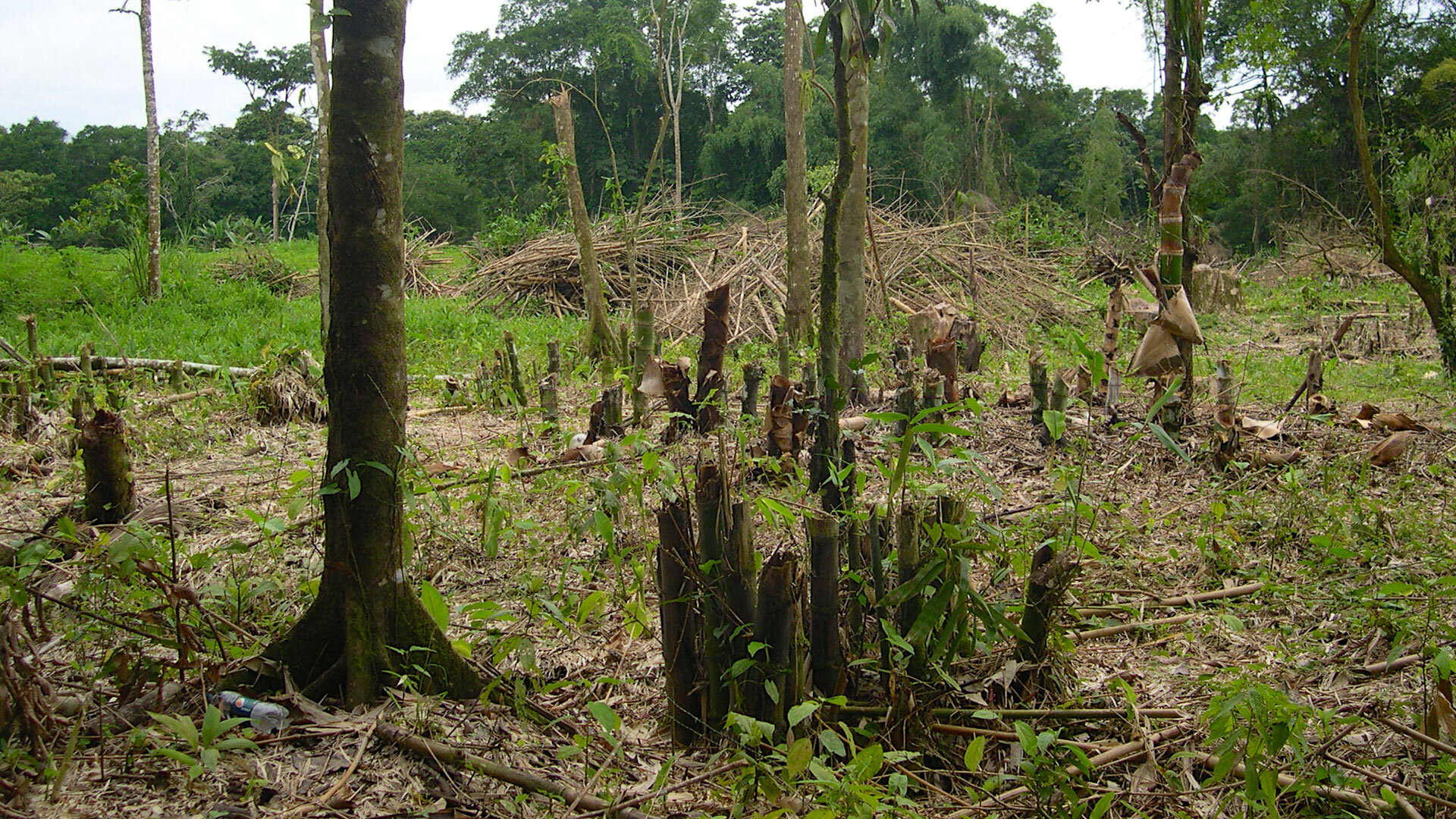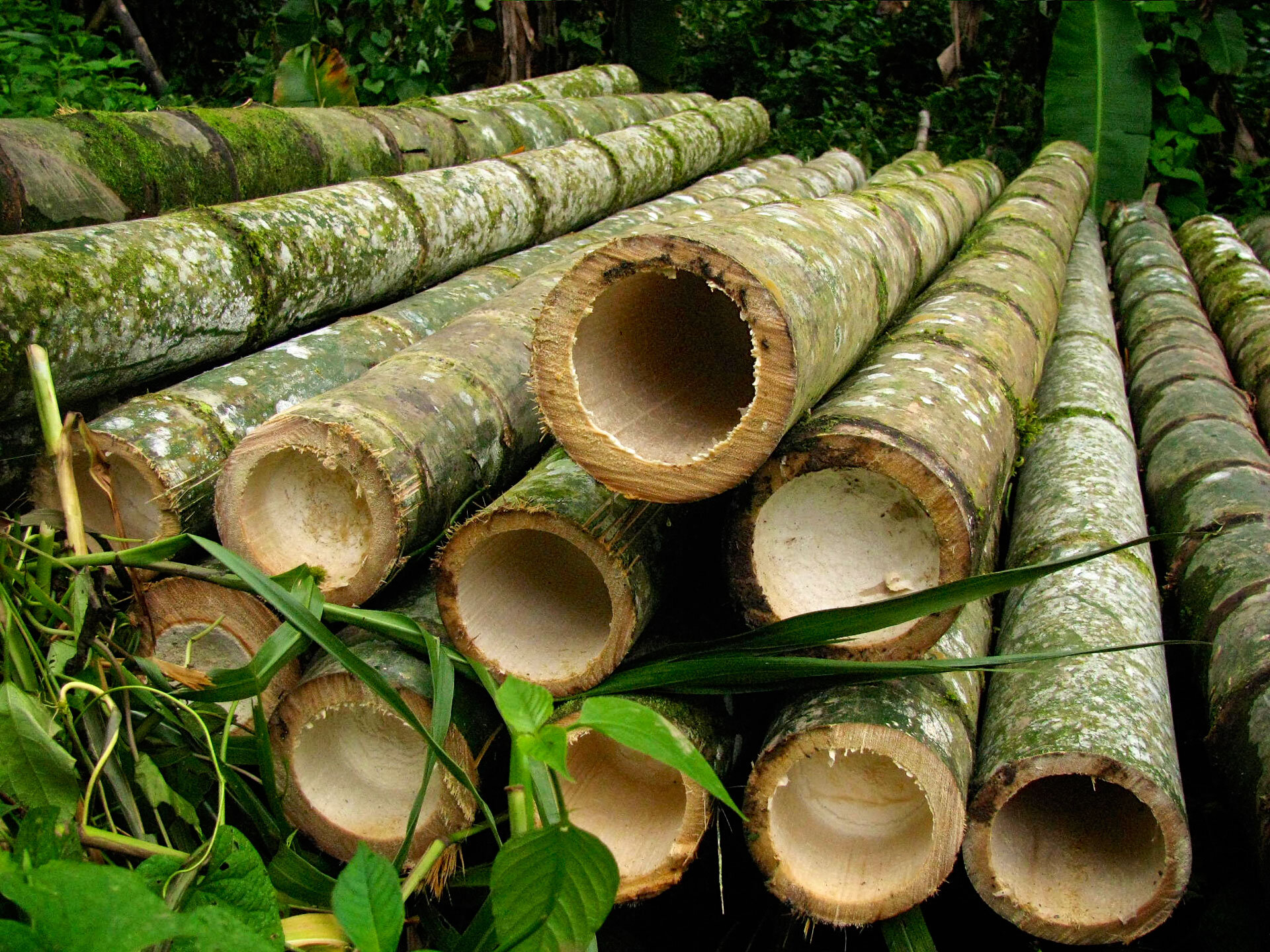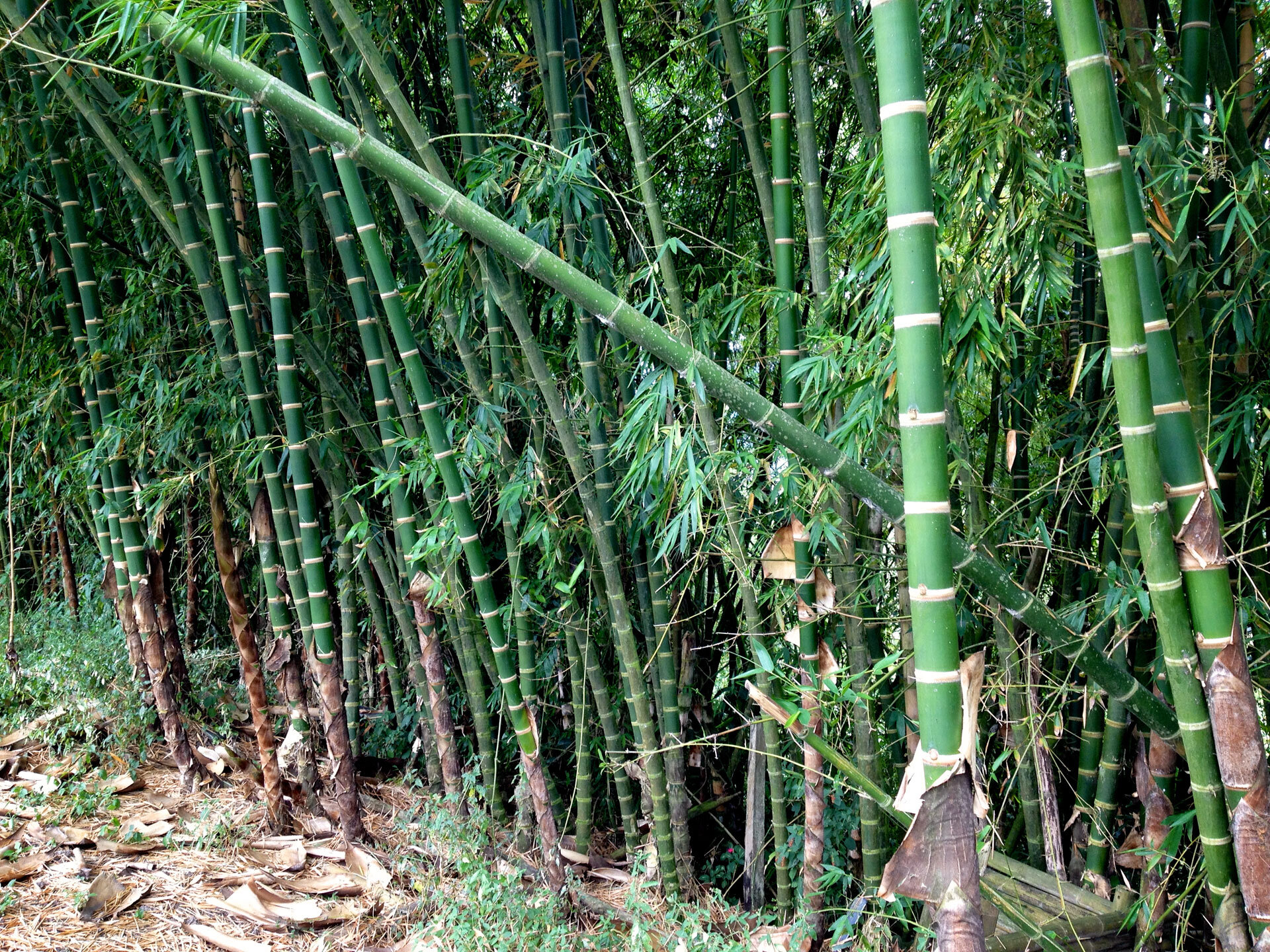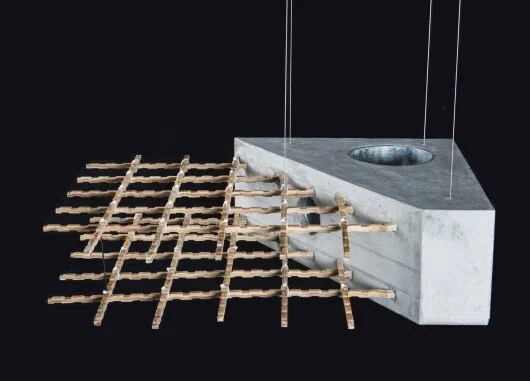
Bamboo Forum
From planting to building, browse questions and
trusted answers from real bamboo experts.
Bamboo Surface Treatment
I want to build a bamboo structure in Maharashtra, India with a very moderate rain fall. Would somebody please suggest me relatively inexpensive bamboo surface treatment which will make my structure safe for at least 20 years.
I want to build a bamboo structure in Maharashtra, India with a very moderate rain fall. Would somebody please suggest me relatively inexpensive bamboo surface treatment which will make my structure safe for at least 20 years.
⭐ Best Answer:
You can treat bamboo with UV blocking polyurethane and it can last for many years. But you will need to re-coat it every year in moderate climates, and re-coat every 6 months in heavily rainy climates. But it does work. I find a gallon of UV blocking polyurethane runs about 40 to 50 bucks in the U.S. And it will coat and area approx. 50 feet long and 6 feet high thoroughly.
Bamboo Turning Black with Outdoor Use
We are doing a project using bamboo as facade under intense sun and rain in summer ( subtropical climate). We did the boric borax solution treatment beforehand already, however under the rain season, some selective bamboos are blackened intensely, why is that and what other solutions/ treatments can prevent such situation from happening?
Hi, we are doing a project using bamboo as facade under intense sun and rain in summer (subtropical climate). We did the boric borax solution treatment beforehand already, however under the rain season, some selective bamboos are blackened intensely, why is that and what other solutions/ treatments can prevent such situation from happening?
⭐ Best Answer:
The blackening you see is almost certainly fungal staining due to high humidity + rain exposure, since boric–borax doesn’t protect against that.
What to do:
Start by cleaning off the surface mold (use mild vinegar solution or lemon oil), then let the bamboo dry thoroughly. Next, apply a UV-resistant sealer, which protects against moisture and UV damage. To prevent recurrence, it’s recommended to re-apply every 1-2 years to maintain protection.
What Determines the Length of Bamboo Internodes?
What determines the length of bamboo internodes? Is it the species only, or are there other factors involved?
What determines the length of bamboo internodes? Is it the species only, or are there other factors involved?
⭐ Best Answer:
The length of bamboo internodes varies greatly from species to species, and the climate and soil it is grown in. Also, bamboo internodes are much shorter towards the base and tip of the culm (stem) compared to the internodal length in the middle of the culm.
Generally speaking the more nodes, the stronger the bamboo. A bamboo culm is at its strongest at the base (largest diameter, more nodes, thickest walls), that's because it has to support the weight of the entire culm, branches and leaves.
So why are the internodes also short toward the tip of the bamboo? This has two reasons:
The branches grow from the nodes. Most bamboo species have little to no branches in the middle of the culm, but primarily at the top, and sometimes near the base. That's why there are more nodes and shorter internodes at the top.
Since there is a lot of weight from branches and leaves at the top, it also has to be strong and flexibel. Hence, lots of nodes and short internodes.
How Many Internodes Has an Average Bamboo Culm?
How many internodes has an average bamboo culm?
How many internodes has an average bamboo culm?
⭐ Best Answer:
In BAMBOOS OF THAILAND there are several tables in which the number of culm-nodes and their corresponding culm length above the ground, the number of internodes, their length, diameter and wall width are listed.
Such tables are available of the following species:
Bambusa pervariabilis, Bambusa textilis, three unidentified Bambusa species, Cephalostachyum pergracile, three unidentified Dendrocalamus species, Lingnania distegia, one unidentified Schizostachyum species, and ×Thyrsocalamus liang.
Can Dry Bamboo be Put Into Water for it to be Able to Bend?
Can dry bamboo be put into water for it to be able to bend? I am also building a grapevine trellis, am I able to cement the bamboo poles into the cement, would it last?
Can dry bamboo be put into water for it to be able to bend? I am also building a grapevine trellis, am I able to cement the bamboo poles into the cement, would it last?
⭐ Best Answer:
No, unlike rattan or willow, bamboo has a hard, lignified outer layer. Once it has dried, its cell walls are set. Water absorption will not restore the pliability of fresh bamboo.
Dry bamboo can be bend by applying force (to a certain extent) but once the force is removed the bamboo will bend back to it's original shape. Therefore it is always best to bend bamboo when it is still green (recently cut).
For agricultural use and support sticks I wouldn't bother using cement as foundations. Exposed to sun and rain the bamboo will weather anyways. A trellis like this could have a lifespan of 2 years (depending on the species, when it was harvested, etc).
How do You Find the Maximum Height of a Bamboo Arch?
How do you find the maximum height of a bamboo arch if you know its length?
How do you find the maximum height of a bamboo arch if you know its length?
⭐ Best Answer:
If you want to find the maximum height of the arch, cut a string the same length as the bamboo, and hang it from two points. That is your arch, upside down. You can impregnate the string with wet plaster, wait for it to harden, and then lay it sideways, and use it as a guide to stake, bend, cut, and shape your bamboo. Just pay attention to the bamboo, and don't let it snap.
Also, make sure your cuts are angled to the focal point, which is an imaginary point between the two points your strung your string two, and should be at the base of your arch. The focal point will be in the middle of those two points, along the line of the shortest distance between them.
Are Shoots of the Ghost Bamboo (Dendrocalamus minor 'Amoenus') Edible?
Are shoots of the Ghost bamboo (Dendrocalamus minor 'Amoenus') edible? When boiling the bamboo shoots, how many water changes are required?
Are shoots of the Ghost bamboo (Dendrocalamus minor 'Amoenus') edible? When boiling bamboo shoots, how many water changes are required?
I harvested Gigantochloa atroviolacea shoots and had kind of a bitter almond cyanide compound odor which dissipated on boiling. What would be the recommended cooking times and water changes to optimize safety and minimise nutrient loss?
On steep rain forest slopes with clay soil in hurricane prone areas, what edible bamboo species would be better for erosion control and withstand uprooting of hurricane force winds? Guadua? I read it spreads out almost like a runner. Does Guadua produce edibility shoots?
⭐ Best Answer:
I did not find any information saying Dendrocalamus minor is edible, nor is Guadua for that matter (with the exception of Guadua sarcocarpa).
Bamboo shoots need to be peeled and cooked before using. Do not eat bamboo shoots raw as they are bitter tasting and can be hard to digest. Trim the roots, peel the outer leaves (sheath leaves), and remove any tough flesh of the shoots before cooking. Tender leaves can be left attached and eaten. The shoots should be cut across the grain into one-eighth inch slices. If very tender, the shoot can be cut into any pattern.
Cook bamboo shoots in boiling water in an uncovered pan for 20 minutes. Leaving the pan uncovered allows the compounds that cause bitterness to dissipate into the air. If there is any bitter taste to the shoots after cooking, boil them in fresh water for 5 more minutes. Bamboo shoots can also be microwaved, in an uncovered shallow pan of water for four minutes. Bamboo shoots will still be crisp and crunchy after cooking.
Removing Toxicity from Bamboo Shoots
The usual practice to remove toxicity from bamboo shoots in the Philippines, is to remove the skin of the bamboo shoots and grate it in a course grater making strings about the size of spaghetti and boil it for about ten minutes. Then rinse the shoots in cold water and then it is ready for any dish.
The usual practice to remove toxicity from bamboo shoots in the Philippines, is to remove the skin of the bamboo shoots and grate it in a course grater making strings about the size of spaghetti and boil it for about ten minutes. Then rinse the shoots in cold water and then it is ready for any dish. Is this enough to remove any toxicity in Dendrocalamus asper shoots?
⭐ Best Answer:
Bamboo shoots of Dendrocalamus asper do contain cyanogenic glycosides (mainly taxiphyllin), which can release hydrogen cyanide if eaten raw. The good news is that taxiphyllin is heat-sensitive — boiling easily destroys it.
The common Filipino method (peel → grate → boil ~10 minutes → rinse) is effective and widely practiced. Discarding the boiling water is essential, since that’s where most of the toxins go. If the shoots are still bitter after boiling, cook them a second time. When prepared this way, D. asper shoots are considered safe to eat.
A study found that boiling D. asper shoots in 5% salt water for 10 minutes reduced cyanogen levels from 0.016 g/100 g to just 0.002 g/100 g, a substantial (88%) reduction, while preserving nutrients.
Are the Outer Leaves of the Bamboo Shoot Edible?
Are the outer leaves of the bamboo shoot edible, good for compost or bamboo broth, or useful for anything besides throwing away? It seems that the vast majority of the shoot is not good for eating.
Are the outer leaves of the bamboo shoot edible, good for compost or bamboo broth, or useful for anything besides throwing away? It seems that the vast majority of the shoot is not good for eating.
I have several other questions as well. First, when I buy canned bamboo shoots, the canning liquid is both edible and tasty. Is this true of the water used for boiling, or must it be thrown out? Is it useful for anything else?
What is the best way to identify an edible variety of bamboo growing wild?
And what are the most commonly sold (in nurseries) types of edible bamboo (that is, which types of edible bamboo would one be likely to find for sale in a nursery)?
⭐ Best Answer:
Outer sheaths of bamboo shoots are not edible — they’re tough, fibrous, and often contain more toxins. Best use: compost or mulch.
Boiling water from fresh shoots must always be discarded, because it collects the bitter cyanogenic compounds you’re trying to remove. This is very different from canned bamboo brine, which is safe because the shoots were pre-detoxified before canning.
Identifying edible bamboo in the wild: Nearly all young shoots are technically edible after proper peeling/boiling, but bitterness varies by species. Always discard the first boiling water, and when in doubt, cook longer.
Most common edible nursery species: Dendrocalamus asper, Bambusa oldhamii, Bambusa vulgaris, and in temperate regions, Phyllostachys edulis (Moso) and Phyllostachys aurea, among many others.
Is Guadua angustifolia Edible?
I wonder if Guadua angustifolia is similar to the Chinese kind of bamboo and if it grows all over Latin American nations? Which Latin country can harvest and export bamboo shoots? I am asking 3 questions here. Can anyone help?
I wonder if Guadua angustifolia is similar to the Chinese kind of bamboo and if it grows all over Latin American nations? Which Latin country can harvest and export bamboo shoots? I am asking 3 questions here. Can anyone help?
Growing Bamboo for Biomass in Greece
I am Panagiotis from Greece and I am interested in growing bamboo in my country. I want to use it for biomass si I need a type of bamboo that produces a lot of mass. I was thinking of something that I can plant at 1 x 1 m apart so I can plant a lot of them. Are there any suggestions to what bamboo species I could use?
Hello, I am Panagiotis from Greece and I am interested in growing bamboo in my country. I want to use it for biomass so I need a type of bamboo that produces a lot of mass. I was thinking of something that I can plant at 1 x 1 m apart so I can plant a lot of them. Are there any suggestions to what bamboo species I could use?
Comparing Biomass of Beema with Guadua Bamboo
Do you know how Guadua compares to "Beema" (Bambusa balcooa) in India propagated by Growmore? Beema bamboo is very thick with a small hole so I'm trying to find reliable 3rd party info on the biomass of a culm when we start harvesting, presumably at the end of year 4.
Do you know how Guadua compares to "Beema" (Bambusa balcooa) in India propagated by Growmore? Beema bamboo is very thick with a small hole so I'm trying to find reliable 3rd party info on the biomass of a culm when we start harvesting, presumably at the end of year 4.
Comments
Ahmed
Beema Bamboo is the solid bamboo compared to other types. “Beema” is a special breed variety by Dr. N. Barathi of Growmore Biotech Ltd., which has a potential to grow very fast and yields very high biomass due to the fact that the wall thickness of “Beema” Bamboo is 3 times more than other bamboo. The carbon content of “Beema” Bamboo is between 46 to 48%. The dry matter production of “Beema” Bamboo under optimum condition reaches 40 to 50 tons per acre or 100 to 125 tons per hectare. The total carbon accumulation every year, after 5 years of growth is from 18 tons to 23 tons per acre, which is equivalent to 69 tons to 80 tons per acre respectively.
Due to this fact, “Beema” Bamboo acts as a “Carbon Sink”. When “Beema” Bamboo is grown individually in the gardens and parks, it sequesters 400 to 500 kg of carbon dioxide every year, thereby reduces the Carbon dioxide in the surrounding places. “Beema” Bamboo generates 70 to 80 CER per acre / year, which is equivalent to 175 to 200 CER per hectare every year.
Carbon sequestration also can be obtained by generating electricity from the renewable biomass of bamboo. One acre of Bamboo produces sufficient biomass to produce 45 MW of electricity through gasification method. Apart from providing 45 CER as Carbon credit directly from the power generation, the process of Pyrolysis generates 7 ½ tons of carbon as bio-char. When the bio-char is supplied to the soil it is eligible for 28 CER as Carbon Credit. The application of bio-char to the soil enhances the crop productivity, improves soil tilt, fertility, water retention. The bio-char in the soil reduces the fertilizer quantity required as well as improves the soil quality of adverse soil resulting in growth of dense vegetation which additionally reduces the soil erosion.
Application of bio-char as soil amendment creates virtually a permanent carbon sink for over 1000 to 2000 years.
Stéphane Schröder
Thanks for copy / pasting this content from their corporate website. Unfortunately this is not a testimonial but their sales page!
It is recommended (by the company promoting this Beema Bamboo) to plant 1000 plants per acre (2470 per ha), which are harvestable in the 2nd year.
Every experienced bamboo growers knows that this is absolutely UNREALISTIC!!!
Beema Bamboo (Bambusa balcooa) is a dense clumper, at this planting distance of 4m2 per clump you could "theoretically" yield incredible amounts of biomass. But this would be true for any large timber bamboo species if planted in such density.
In fact, if 2470 Guadua angustifolia plants would be planted per hectare (instead of the recommended 238-400), the total accumulated biomass generation of 1 ha after 5 years would be: 1,548 ton, with 772 ton carbon fixation (yes, that's even ten times more than this Beema Bamboo).
Of course this is "just theory" since giant tropical bamboos can't grow to their full potential on such small distances. Furthermore, it is impossible to selectively harvest in such dense plantations. The bamboo must be clear cut after x amount of years, which beats the purpose of sustainable harvest, but it is of course a great marketing model for selling these seedlings!
Ahmed
Beema Bamboo is a solid bamboo, there is no doubt about that. Beema bamboo is cloned from an Indian variety of bamboo. From the recent govt research, it was proven that Beema bamboo results in high biomass. It has proven that just 200 acres are required to generate 1MW of electricity.
Beema bamboo grows at the speed of 1-1/2 feet per day.
Robin
Hello Stephane, what kind of bamboo would you suggest for an 300 acre energy plantation?
Stéphane Schröder
There are plenty of bamboo species that can be planted for energy production, but it will depend on what climate and soil you're planning to grow the bamboo. In tropical climates Bambusa, Dendrocalamus, and Guadua would do best since they are all giant timber genera. In temperate climates Phyllostachys would be the best choice.
I'm not saying that Beema bamboo or Bambusa balcooa aren't suited for energy production, just be careful with those astronomical yield projections.
Ahmed
If you are planning to plant the Energy plantation. I would suggest you to plant the Beema Bamboo for those 300 acres. Because there are plenty of reasons for planting Beema:
- You can plant up to 1000 plants / acre or 2500 / Ha
- Can start yielding from the second year
- Contains high biomass
- Thornless
- Thick walled
Stéphane Schröder
Ahmed, if you state that bamboo can be harvested 2 years after planting then I'm 100% sure you do not have any experience with bamboo cultivation nor are you a trustworthy source or good ambassador for Growmore Biotech, sorry.
Such claims do not only harm that company, it also harms the overall perception towards the bamboo industry in general. It's about time all these "too good to be true" stories about bamboo come to an end
Bob
I found the real contents of this post was not a comparison between Beema and Guadua but a battle between their respective supporters namely Ahmed and Stephane. I myself planted Beema since June 2011 and it is so good so far. Thick walled & high density, suitable for biomass production. That's all what I can inform to you all. Wishing you all the best.
Stéphane Schröder
Again Bob, I am not saying Beema bamboo isn't a good biomass producer, I am only disputing the REAL yield numbers here. You say it is a thick walled and high density bamboo which we already know, the question is how many (scientifically proven) tons of biomass are you currently harvesting per hectare per year?
Steve Suarez
I live in the Philippines and I am interested to know if there are matured Beema bamboo plantations here in our country for us to see. It's really hard to convince other people about the potential of this variety as a biomass fuel until we can see a demo or pilot plantation and power plant working in tandem successfully.
Joseph
We have a 30 hectare plantation of Beema in the Philippines. We started to plant in the first area in May 2012. The plants are now 9 meters high and all are thick walled.
Typhoon Haiyan bent some of the taller bamboo clumps so we had to cut them. All of them were thick walled about 25 mm thick.
If you want to visit the plantation you have to travel to Tablas Island, Romblon. We are in the town of Odiongan.
N. Barathi
Dear Mr. Stephane,
I regret to note the comments made by you on Beema bamboo. I am Dr. Barathi, a bamboo scientist from India who has developed the Beema bamboo and intensive farming in bamboo.
Beema bamboo is the superior genetic selection made by me out of Bambusa balcooa, and I am sure other bamboo scientists can also develop good genetic clones from other species of bamboo.
There are many Beema bamboo farms available in India and abroad. It is not theoretical but practically it is happening. I am sure you would know that a crop like sugarcane is planted with 30,000 plants in an acre yielding 40 tons to 100 tons per acre in one year's time. I have been working in sugarcane for a decade developed the intensive farming in Beema bamboo with only 1,000 plants and to give 40 tons after 2 years. I am sure you are aware that bamboo grows 10 times faster than sugarcane and 3 times taller than sugarcane.
Thanks, Mr. Bob, Mr. Joseph and Mr. Ahmed for sharing your experience of Beema bamboo.
I am thankful to "Guadua Bamboo - Bamboo Forum" to bring up the discussion and post these comments.
GPS
I am a farmer in the TARAI area of Uttarakhand. I am considering to go in for a bamboo plantation, to replace, Poplars. In my quest for elite planting material, I have travelled across most parts of India (Bamboo growing regions- Bihar, Orissa, M.P, Assam, Bengal, Maharashtra etc) and have been in touch with quite a few universities.
I have collected 5 to 6 genotypes, which I found interesting and having good growth potential. I have made a small little nursery plot to study- and eventually select suitable genotype(s) to scale-up.
I also got in touch with GROWMORE - requested them to provide cuttings - which they refused. They said that they will sell a minimum of 1000 tissue cultured plants, and that they were patented property. When I mentioned that my interest was to procure a few mother plants, for further vegetative propagation I was refused any planting material and was told that multiplication by V.P method would BE ILLEGAL, which I doubt very much.
I would like to highlight that the so called beema bamboo exists in Bihar, M.P etc and is not a "new" finding, thereby not patentable.
Yes I am inclined to believe that growmore is a scumbag.
rij gurung
Hello GPS,
We are grassroots environmental social entrepreneurs based in Nepal and have a plan to go for a community based plantation of bamboos. We have similar topography like Uttarakhand. My attention was drawn to the comments you made on the experiments that you are undertaking to eventually select the best suitable genotype. Is it possible to communicate with you for exchanging ideas? Looking forward to hearing from you. With regards. Rij. P.S. Thanks Guadua for providing such an excellent platform to exchange ideas and information on bamboos. Thanks.
JK
Good to know that Beema Bamboo is a result of years of dedication and innovation, and claimed to be the best. But without published scientific study and evaluation of its yield numbers in real world conditions, it would be hard to believe. Its interesting that Growmore has no time to substantiate its own bold claims. Let the data speak the truth.
Bryce
Why is it never not any anywhere mentioned the difference between the cultivar beema vs the standard balcooa species? I am very curious of that figure. I suspect it's just a regular balcooa being marketed as an improved cultivar which going by the numbers it just sounds like every other balcooa there is.
Pratham Prajapathi
I have 20 acre land in Rajasthan, can you please tell how many plants can be grown in so much space and how much electricity can be produced if I plant beema bamboo. And if there are any disadvantages please tell me.
vivek sharma
Per acre 950 plants. Government gives 120 rs per plant as grant for first two years.
a) 30 within 90 days of plantation
b) 30 after180 days of plantation
c) 30 second year of plantation
d) 30 third year of plantation.
Gurpreet Singh
Hi..
The above has been an interesting reading.
I have been experimenting with various tropical bamboo species in Terai...
Nutaans, Balcooa and Vulgaris green were procured from Gobind Ballabh Pant Univ of Agriculture and Tech (GBPUAT)....ALL ARE DOING VERY WELL..
Spacing... for all these large bamboo species a minimum of 5m by 5m is essential.......
I have tried Guadua too, and surprisingly, it has responded well to our agro climate...
Initial 2 years they were slow... because probably our cuttings had a very small / feeble root system...
I had made a rhizome bank.... and I am happy to report that good number of rhizomes (offsets, culms) are seen on each...
I propose to scale up... and as suggested above, plant at 5 m by 5m.... about 400 plants per Ha, or 180 per acre...
Pretty happy with this experiment.
I have been hearing of thornless guadua..... I really don't know if at all a thornless guadua exists????
I have also set up experimental plots of Stocksii, Oliverii, Setigera, Membranaceous, Lako, Atroviolacia, Giganteus, Hamiltonii,....
The only species not doing well in terai is giganteus...
Our weather is somewhat like Assam... so I guess, pretty suitable for bamboo.
Making a Bamboo Fish Mouth Joint
This video from the Technology Institute in Costa Rica shows a basic technique in bamboo construction: the bamboo fish mouth joint. Notice the backslash of the drill in the beginning of the video. Guadua bamboo is a thick walled timber species, so be careful when you try this at home!
This video shows how to make a clean fish mouth joint using only a drill and a hole saw. It’s a simple step-by-step process that takes less than a minute to complete. Perfect if you want a fast and accurate fit. (The video is in Spanish, but the steps should be pretty self-explanatory.)
Guadua Rhizome Morphology
I want to compare Guadua angustifolia and Ethiopian mountain bamboo in their rhizome morphology, but I become confused with the two different rhizome positions of Guadua angustifolia mentioned. I need clarification about rhizome forms of the species.
I read about two different rhizome positions of Guadua angustifolia (nearly vertically positioned rhizome with collective feet and horizontally positioned rhizome).
Here in Ethiopia, North East Africa, there is mountain bamboo that has a similar rhizome position (nearly vertically positioned) with collective rhizome feet. I want to compare Guadua angustifolia and Ethiopian mountain bamboo in their rhizome morphology, but I become confused with the two different rhizome positions of Guadua angustifolia mentioned.
I need clarification about rhizome forms of the species. I would appreciate it if you can show me pictures as well.
Comments
Stéphane Schröder
I'm not exactly sure what you mean with vertical vs horizontal positioned rhizomes but I assume you are referring to Guadua's underground growth habit. So, I think the question should be: Is Guadua angustifolia a running or a clumping type of bamboo?
There is quite some confusion about the rhizome structure of Guadua angustifolia as Guadua species are classified as clumpers, however the reality is quite different...
The long-necked rhizomes can easily extend one meter or more before turning upwards into a new culm, and outdistancing some bamboos with leptomorph (running) rhizome systems. Rather than "clumping" bamboo, Guadua bamboos are more properly characterized as having a pachymorph rhizome system with a diffuse habit (or "open clumpers") – though even this often understates the matter.
Guadua Bamboo Rhizome Morphology
Bill
The real question I'd like to see an answer to is... can they be contained once planted, or is it inevitable they will take over the property over time?
Stéphane Schröder
They won't take over your property like running bamboos since Guadua still grows in clumps. However these clumps will continue to expand and can become 10 meters in diameter in about 10 years (under optimal conditions). So I won't advise planting them in a backyard of a few square meters.
Simple rhizome barriers won't hold up against these massive Guadua's but you could somewhat keep them under control by eliminating the young shoots (just chop them down).
Using Bamboo Underwater for Floating House Design
I am working on a floating house design and would like to use bamboo as a floating foundation. Now my question is how long will bamboo that is partially underwater last?
I am working on a floating house design and would like to use bamboo as a floating foundation. Now my questions are:
How long will bamboo that is partially underwater last?
Is there a difference between permanently underwater and alternately underwater?
How can you best process the bamboo to stay in good condition for as long as possible?
Is there a difference if the house is in fresh or salt water?
⭐ Best Answer:
Bamboo can work as flotation if it’s treated and either kept always underwater or always above water.
1. How long does bamboo last when partially underwater?
Partially submerged (splash zone): This is the worst case. The alternation of wet/dry cycles with oxygen exposure accelerates fungal decay. Untreated bamboo here often lasts only 1–3 years.
Fully submerged: In low-oxygen water, bamboo can last 10–15 years or more in freshwater. In fact, waterlogged archaeological bamboo has survived centuries.
2. Permanently underwater vs. alternately underwater
Permanently underwater: More durable, as oxygen is limited and fungi cannot thrive.
Alternately underwater: Much shorter lifespan due to swelling/shrinkage, UV exposure, and microbial attack at the waterline.
3. How to process bamboo for best longevity
Proper harvest: Use mature bamboo (4–6 years old).
Preservation methods:
CCB (safe and fixating insect/fungal protection).
CCA (stronger preservative if environmental regulations allow).
Physical protection:
Resin/epoxy coatings.
Wrapping the submerged section with a waterproof membrane.
Design principle: Keep bamboo either always submerged or fully above water. Avoid the alternating splash zone whenever possible.
4. Freshwater vs. saltwater performance
Freshwater: Main risks are fungi and bacteria. With treatment, bamboo can last a decade or more if fully submerged.
Saltwater: Adds marine borers (shipworms, gribbles). Untreated bamboo may be destroyed in months to a few years. Strong protective coatings or hybrid floatation systems are essential.
Practical Recommendations:
If using bamboo for flotation, make airtight pontoons (bundled bamboo sealed with resin/tar, or enclosed in a membrane).
In freshwater, treated bamboo pontoons can be serviceable for many years.
In saltwater, consider hybrid designs: bamboo combined with plastic drums, ferrocement, or other durable floatation elements.
Filling Bamboo Joints with Cement
I saw some info about creating strong bamboo joints when using Guadua in building construction, especially adding cement to the joints. I recall threaded rod and hardware being used, and possibly rebar as well. I would love to see more detailed info and/or videos about that.
I saw some info about creating strong bamboo joints when using Guadua in building construction, especially adding cement to the joints. I recall threaded rod and hardware being used, and possibly rebar as well. I would love to see more detailed info and/or videos about that. Perhaps there are some good videos on the site already that I have missed.
⭐ Best Answer:
Filling bamboo poles to reinforce the joints has shown very limited results. The problem arises from the fact that the cement mixture has water in it. So when injected in the bamboo cavity the bamboo sucks up part of the water from the mixture and the bamboo fiber swells up. When the cement or concrete sets it hardens and the bamboo dries. So it shrinks again. Pulling itself loose from the cement core and leaving a capillary opening between the bamboo and the cement. In addition to that, cement is very good at taking pressure-loads, but terrible at tensile strength (pulling). And it is heavy. So making a lightweight construction with bamboo does not seem to make much sense if you want to use heavy cement or concrete joints. Usually the motive for using cement is that it is cheap, and the builder (not being specialized in bamboo building but in general building) knows cement, but lacks the knowledge of using it in combination with bamboo.
There are better alternatives. One of them is using bamboo fiber with a matrix. A matrix is just a glue of some sort that fixes the fiber in place, mostly polymers made by chemical industry. Unfortunately good matrix-es usually do not come cheap and mostly are not very eco-friendly. But technically they are good and reliable. Basically what you do is building an exoskeleton of bamboo fiber held in place with the glue around the connection. Pretty much like you would make a cast around a leg when someone has a broken bone. The best results we had with a pre-woven strip of about 5 cm wide wrapped around the column in a cross overlapping pattern in MANY layers and then saturating it with the polymer. The best result are achieved when assuring both chemical AND mechanical bonding between the matrix and the bamboo. Mechanically is easy: roughen up the contact surface. Chemically is harder. But usually when you use a matrix that is properly absorbed by the bamboo fiber it should be ok. Keep in mind that the outside layer of the bamboo is not just hard by itself, but is hard because it contains a high level of silica. Making it more weather resistant, but also more anti-adhesive. Scraping it of before you apply the fiber and matrix might be a good idea.
What is the Best Bamboo Species for Making Floors?
I am considering bamboo as a flooring material. Are some species better than others for bamboo flooring?
I am considering bamboo as a flooring material. Are some species better than others for bamboo flooring? Love your site. So informative. So readable. Keep up the good work!
⭐ Best Answer:
Choosing the right species for bamboo flooring is crucial, because the strength and hardness of bamboo fibers varies greatly between species. Generally, the best timber bamboos come from the genera Guadua, Dendrocalamus, Bambusa, and Phyllostachys.
The most widely used species in Asia is Moso (Phyllostachys edulis), while in the Americas the preferred species is Guadua (Guadua angustifolia). Both are excellent flooring bamboos, but they differ in fiber density, growth habits, and availability. You can see a comparison of both species here.
It is also worth noting that Moso Bamboo is among the hardest bamboo species in the world, making it highly suitable for flooring applications where durability is critical.
Bamboo as Reinforcement in Concrete
I am working with others developing a new kind of town and it would be consonant with the sustainability goals of the project if bamboo could replace some or all of the steel rebars in the concrete construction planned for all the buildings in such towns. Is there any experience, research, testing, or certification of bamboo concrete reinforcement?
I am working with others developing a new kind of town and it would be consonant with the sustainability goals of the project if bamboo could replace some or all of the steel rebars in the concrete construction planned for all the buildings in such towns. Is there any experience, research, testing, or certification of bamboo concrete reinforcement?
⭐ Best Answer:
There are a lot of test results available online for reinforcement of concrete with bamboo, here are a few of the most important references:
Image © Professorship of Architecture and Con- struction Dirk E. Hebel, ETH 3) Zürich / FCL Singapore
Research and Development on Bamboo Reinforced Concrete Structure
Experimental Investigation of Bamboo Reinforced Concrete Slab
Building Bamboo Reinforced Masonry in Earthquake-prone Areas
Investigation on Behaviour of Bamboo Reinforced Concrete Member
We also had an interesting discussion about using bamboo for reinforcing concrete on our Facebook page:
Treatment for Bamboo Poles Buried in Soil
I want to use bamboo poles as structural elements in my ranch but we have water sprinklers to keep certain crops fresh all year. How can we treat the poles in order to keep it in use at least 6 years buried in soil inside the wet ground?
I have a question regarding bamboo treatment. I want to use bamboo poles as structural elements in my ranch but we have water sprinklers to keep certain crops fresh all year. How can we treat the poles in order to keep it in use at least 6 years buried in soil inside the wet ground? Poles will be buried 3 ft in the ground.
Would the bamboo lose strength with time? How do I preserve and extend the lifespan of the bamboo? What would be the lifespan of the bamboo after the preservative treatment? I was thinking to use busan 1009, do you recommend it? Thanks for your comments.
⭐ Best Answer:
Generally speaking it is not recommended to use bamboo buried in soil for structural purposes. You should use chemicals to extend the lifespan of bamboo buried in soil, but just as most timber, bamboo will eventually deteriorate even if chemically treated.
I have no experience with busan 1009 but what we use to protect bamboo poles in ground contact is tar. Tar or creosote isn't exactly an eco-friendly product, but it is cheap and does provide excellent protection. I recently dug out some bamboo fence posts treated with tar, and they were still intact after 10 years.
The best way though is to chemically preserve the bamboo poles and to design a structure where the bamboo poles don't touch the soil directly. A concrete foot or large rock for example would work great.
Fire Resistant Protection for Structural Bamboo
I have a question for my research, what would be the best preservation technique to use on structural bamboo? It needs to be fire resistive too. Will a boric acid-borax solution suffice? Or would an additional clear external intumescent coating help?
I have a question for my research, what would be the best preservation technique to use on structural bamboo? It needs to be fire resistant too. Will a boric acid-borax solution suffice? Or would an additional clear external intumescent coating help? What do you guys think? Thanks in advance. I appreciate the information you guys put here Guadua Bamboo.
⭐ Best Answer:
Yes, boron is fire retardant but for even more protection you could use the following formula: boric acid / copper sulphate / zinc chloride / sodium dichromate : ratio 3:1:5:6 Recommended concentration is 25% for indoor and outdoor use.








